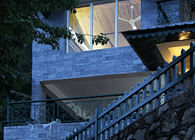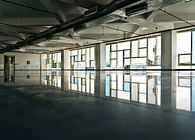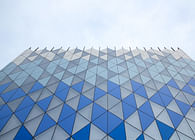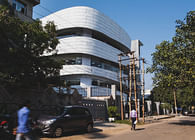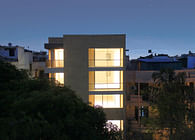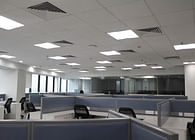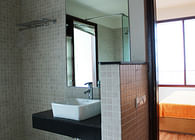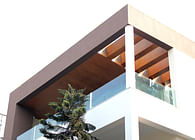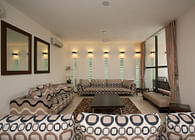
New Delhi, IN
Culturally, as the world moves towards a more sustainable approach to building, consumption and resource allocation, the extravagance of construction methods and choices over the past century has rightfully come under great scrutiny. The economic turmoil of the past decade has also raised important issues regarding the capital investment in architecture. Now more than ever, cities need prudent construction solutions that are aware of technology, context and do not compromise on spatiality or aesthetics, but rather augments them in a more ‘appropriate’ manner.
Located in a rapidly densifying part of Noida, a suburban region to the east of New Delhi, the 3200SF site is set along a series of private family residences. The zoning plan necessitated sharing a blank wall with the neighbour to the south, with the building line pushed back from the site edge in the other three directions. Conceived as a composition of primary volumes, this three-bedroom house is designed for single family use, with the possibility of being able to add a fourth bedroom should the need arise.
The house is envisioned with three main design elements on the front façade - a circular drum as a living space is juxtaposed against a triangular wedge that contains the services, while a rectilinear cube establishes the boundary conditions. The building crafts an identity not only by geometrical forms, but also by materiality - the use of a perforated brick screen celebrates the famed Indian sun, while providing shade along the front surface of the wedge. The two volumes are separated with a slit window of the bedroom that helps accentuate the intersection. A large portion of the circular living space is carved out along the views towards the community park on the front east corner of the site to allow for a seamless flow of visual connectivity from the enclosed internal spaces to the front garden and the park. The whole composition is framed in a rectilinear concrete square that is aligned to the diagonal east facing cut-out, orienting the overall geometrical composition.
In order to amplify the scale of the living areas and maximise spatial planning, no partitions divide the living and dining areas. Upon entering through an open green space that looks out to a park in the front, a unified space greets the visitor, opening up to the outdoors in three directions. This central space, segregated from the elements by floor to ceiling windows, combines privacy with open plan living and a seamless connection to the framed views. An existing ‘Ber’ tree (or Ziziphus Mauritiana) towards the rear of the site has been retained, with the rear bedroom and dining space being orchestrated around it to create an external courtyard, that acts as a shaded spill-out zone. A small foyer connects the living area to the two bedrooms with attached bathrooms on the ground floor as well as the staircase that leads upto the bedroom on the first floor, opening up into the terrace. An oculus over the stair washes the entire space with sunlight, illuminating the central part of the house. Large windows with thin black metal frames allow the internal living spaces to flow into the front and rear spaces at the ground floor level. The square metal frames also allow for ample light and ventilation into the building, whilst reducing the visual density of the different volumes. The windows along the toilet block in the front wedge have been shaded with a traditional brick screen or jaali, that provides thermal comfort and privacy on the inside, and a dramatic and dynamic interplay of light and shadow on the exterior.
Built at a budget of less than $18 per square foot within a timeframe of 6 months, the house establishes itself as a prototype of low-cost, sustainable urban housing, to ensure a pragmatic shift in the overall approach to design and construction strategies. The building is constructed primarily in exposed brick and concrete, lowering its cost of construction considerably, while allowing for endurance and material expression. Additionally, the cost of the metal frames in the windows is much lower as compared to typically used wooden frames that need to be coupled with additional grills for safety. Light grey, locally available Kota stone is used for the flooring that complements the overall aesthetic of the house. LED lighting and low-flow faucets enhance the energy efficiency of the building, as does the overall plan, designed to minimise heat gain in summers, while providing adequate levels of daylighting. Soft paved surfaces around the house allow for ground water recharging and reduce reflective glare into the building. Additionally, reflective tiles on the roof are expected to reduce the heat load, and the exposed concrete ceiling in the interiors will not need any repainting.
Buildings should be representative of the epoch in which they are built, and this has always been true for great buildings throughout history. Contemporary buildings often struggle to encompass the larger issues of sustainability, efficiency and frugal use of resources - choosing to conform to predetermined aesthetic criteria instead. With this house, it is hoped to reverse that trend, to create a truly responsible architecture that belongs to the time in which it was designed and built.
Status: Built
Location: New Delhi, IN
Firm Role: Architect


